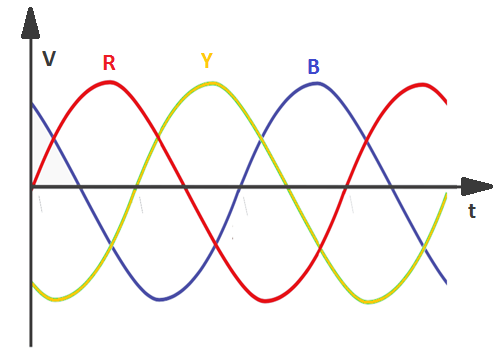How Induction Motor Works? Explained with Diagram
An electrical motor is an electrical machine that converts electrical energy into mechanical energy. According to the types of power supply, there are three types of electrical motor - 1. DC Motor(which works on DC Supply) 2. AC Motor(which works on AC supply) 3. Universal Motor( which works on both AC and DC supply).
The most usable AC motor works on the principle of electromagnetic induction so they are called Induction motor. The induction motor is the most usable motor and has a lot of advantages over other types of motor such as simple construction, simple starting methode, easy speed controlling, high efficiency, etc. In this article, we are going to know the working principle of induction motor.
Induction Motor Working Principle
Basically, a three-phase Induction motor has two main parts in its construction - stator, and rotor. The stator consists of a three-phase winding that is to be connected to the power supply. The rotor is free to rotate and it also has a short circuit winding.
So when the three-phase power supply applied to the stator winding it produces a Rotating Magnetic Field(RMF). Once the magnetic field is produced by the stator winding an electromagnetic induction happens between stator and rotor winding. As the rotor winding is short-circuited so it also created a magnetic field. Now due to the interaction between rotor magnetic field and stator magnetic field torque developed on the rotor and the rotor starts rotating as it free to rotate.
The induction motor works on the same principle as Transformer. Here we can consider the stator winding as the primary winding and the rotor winding as the secondary winding. So it is not interesting that how an induction motor works, but it is more interesting and must to know how rotating magnetic field produces in the stator field for which induction motor rotates.
How Rotating Magnetic Field(RMF) produce in Induction Motor?
RMF or Rotating Magnetic Field is the main phenomenon for the rotation of induction motor. The production of a rotating magnetic field depends upon the arrangement of the stator winding, frequency, and alternating property of the three-phase AC supply. The magnitude and polarity of the AC supply changes with time. The magnitude always reaches to zero value and its peak value. In a three-phase AC supply, the voltage in all three phases does not reach the peak value at the same time.
In the above diagram, you can see first, the R phase reaches to its peak value, then the Y phase then the B phase. So this property helps a lot to produce the rotating magnetic field in the induction motor.
Here a diagram is given below to easily understand how the rotor rotates with changing magnetic fields.
Here you can see the stator winding has three coils - A, B, C. In practice there are so many coils are placed like this way. To understand easily, we take three coils only. You can see Coil A, B, C are connected to R, Y, B phases respectively. Now if the three-phase AC supply applied to the stator winding, according to the nature of the three-phase supply, first coil A will be energized then Coil B, then Coil C, and this will be repeated depending upon the frequency of the supply. So, now you may understand that coil A, B, C are energized in such a way that it produces a rotating magnetic field. Thus the rotor of the induction motor rotates with the rotating magnetic field.
Also, note that here we talking about three phase induction motor. It does not required any push at starting like an singe phase induction motor. The three phase induction motor can start automatically.
Speed of the Induction Motor
The speed of the induction motor or speed of the Rotor is completely dependent upon the speed of the rotating magnetic field or RMF because due to that only the rotor can rotate. So if we control the speed of the RMF, the speed of the rotor also be controlled. The speed of the rotating magnetic field is called Synchronous Speed.
The speed of the rotating magnetic field can be controlled using two methods - 1. Frequency control 2. Increasing and decreasing of no. of poles.
The second method - increasing and decreasing of no. of poles not possible when the motor is in running condition so the first method, frequency control is used. When the frequency of the three-phase AC supply is increased the speed also be increase and vice versa. So, a variable frequency drive or VFD can be use to control the speed of the induction motor.
Remember that, the speed of the induction motor cannot be controlled accurately by varying the supply voltage because a large change in voltage gives a very small effect on changing of speed. In fact, it is not recommended to vary the supply voltage when it is connected to a heavy load. An induction motor with a heavy load always should be operated at the rated voltage. If we reduced the supply voltage below the rated voltage suddenly it will draw excessive current and the winding may be burned. So, the speed control by varying supply voltage only suitable for single-phase or low power induction motors.
Read Also:
- Why Induction Motor draws more No Load Current and High Starting Current?
- Advantages of both STAR and DELTA connection in Induction Motor
- Why the Rotor of Slip Ring Induction Motor always Star Connected?
- Why the Rotor of Induction Motor is Skewed? Need of Skewing
- Why Three Phase Induction Motor Self-Starting but Synchronous Motor not?



